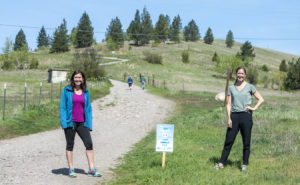
By Kasey Rahn, UM News Service
Missoula’s wide-open spaces have perhaps felt a bit more crowded these days as residents flock to local trailheads seeking exercise, fresh air and a sense of normality during COVID-19.
Outdoor recreation provides much-needed relief during the pandemic, but increased use of recreational areas also can bring potential challenges, such as employee safety hazards, parking congestion, private-property-rights issues, conflicts between trail users, resource damage and potential health risks.
Two University of Montana researchers, in conjunction with Missoula Parks and Recreation, are quantifying how COVID-19 has affected the ways people use Missoula’s outdoor spaces during the pandemic to help park officials better understand and manage changing recreation trends.
Associate Professors Jennifer Thomsen and Libby Metcalf, social science researchers in UM’s W.A. Franke College of Forestry and Conservation, built an online survey that asked residents about their trail use during COVID-19 restrictions. More than 650 responded.
“Outdoor recreation is important for coping, but how do we make sure it’s done in a safe way? There’s lots of interest in this from both park and rec managers and the community,” said Thomsen, an associate professor of parks, tourism and recreation. “We’ve all seen examples from other states where trails or beaches have been closed. There was this fear: Is this going to happen in Missoula? Parks and Recreation is trying to find out about changes in use and peoples’ decision-making and awareness – are they safely recreating? If they are going to keep these places open, this data could be really important.”
“We asked questions about how people are recreating in the pandemic with increased use on trails,” said Metcalf, associate professor of human dimensions of natural resources. “Are you going with different people or at different times of day? We wanted to know how people are altering their behavior to stay safe but still have that outlet.”
The researchers still are analyzing the data and will release a full report to Missoula Parks and Rec later this spring. Preliminary findings indicate that 40% of respondents are using new trails and parks as a result of the COVID-19 stay-at-home order, and 77% of the respondents say hiking on trails is the most common recreation activity. Forty percent of respondents said they recreate when areas are less crowded.
The early survey results also showed that 98% of respondents indicated they were socially distancing on trails.
“We know from previous research in Yellowstone that people have very different perceptions about how far away they are,” Metcalf said. “We’ve done similar studies regarding wildlife in Yellowstone. People think they are 30 feet away from a bison, but they are actually 10 feet away. It will be different to see how this applies to social distancing on trails.”
Thomsen and Metcalf included questions about where people are going and what activities they would normally otherwise be engaged in – like a fitness class or participating in a team sport. They also wanted to understand participants’ motivations for recreating outdoors during COVID.
Preliminary results suggest respondents are motivated to experience solitude (62%), to rest mentally (53%), to be close to nature (53%) and to relax physically (52%).
A portion of the survey also addressed signage at trailheads to help Parks and Rec determine what is effective and how best to communicate with constituents. Many of the respondents have found the signage at trailheads and parks to be moderately helpful. This information also will aid in updating and educating residents and visitors, said Donna Gaukler, director of Missoula Parks and Recreation, who helped design the survey and works closely with Metcalf and Thomsen.
Beyond the health and safety of park visitors and employees, Thomsen said, there are concerns about the impacts increased traffic will have on natural resources.
“It’s the perfect storm. It’s spring time. The weather is nice. People want to get outside, and because of the COVID restrictions, people don’t have many other options for recreation,” Thomsen said. “But you also have fragile vegetation that blooms now and wildlife are becoming active. New behaviors have to be learned by all. How do you maximize safety, but also how do we protect these sensitive resources? There are a lot of unknowns, but it’s really important to assess these baselines now and then continue throughout the season, so managers have the data to help make decisions and can explain those science-based strategies to the public.”
The researchers hope to use the survey to help support Parks and Recreation staff, who have worked hard to ensure open spaces in Missoula remain open.
“We often forget in the community that our public lands and open spaces require maintenance. When you dump a whole bunch of people on trails that have never seen use like this, it creates cascading effects,” said Metcalf. “Managing outdoor spaces requires human resources. How do we meet the needs of the community and keep our employees safe?”
As academic researchers, Thomsen and Metcalf also are interested in understanding how outdoor spaces serve as coping mechanisms in times of crisis. They plan to conduct a more in-depth analysis related to recreation and mental health during the pandemic and to eventually submit the results for publication in a peer-reviewed scientific journal.
The two said they see the uptick in recreation during the pandemic as an ultimately positive thing.
“My hope is that eventually all these new users will create new conservation advocates,” said Metcalf. “Conservation often comes back to votes. I hope our community puts together another open space bond in the future. We want to be able to conserve later on. It will ultimately improve conservation down the road. It also makes a point for strong educational programs.”
